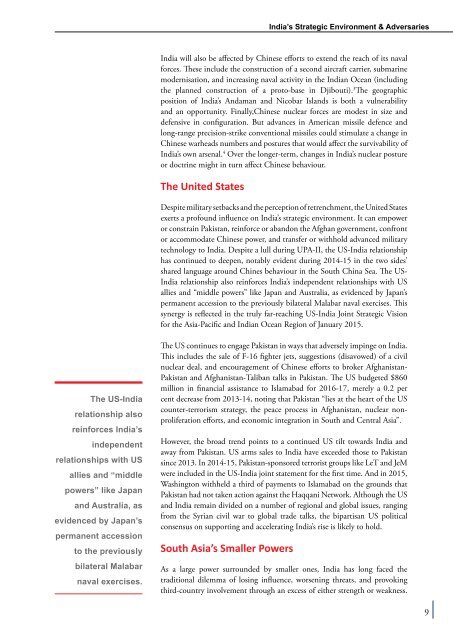Defence Primer
Military_Layout
Military_Layout
Create successful ePaper yourself
Turn your PDF publications into a flip-book with our unique Google optimized e-Paper software.
India’s Strategic Environment & Adversaries<br />
India will also be affected by Chinese efforts to extend the reach of its naval<br />
forces. These include the construction of a second aircraft carrier, submarine<br />
modernisation, and increasing naval activity in the Indian Ocean (including<br />
the planned construction of a proto-base in Djibouti). 3 The geographic<br />
position of India’s Andaman and Nicobar Islands is both a vulnerability<br />
and an opportunity. Finally,Chinese nuclear forces are modest in size and<br />
defensive in configuration. But advances in American missile defence and<br />
long-range precision-strike conventional missiles could stimulate a change in<br />
Chinese warheads numbers and postures that would affect the survivability of<br />
India’s own arsenal. 4 Over the longer-term, changes in India’s nuclear posture<br />
or doctrine might in turn affect Chinese behaviour.<br />
The United States<br />
Despite military setbacks and the perception of retrenchment, the United States<br />
exerts a profound influence on India’s strategic environment. It can empower<br />
or constrain Pakistan, reinforce or abandon the Afghan government, confront<br />
or accommodate Chinese power, and transfer or withhold advanced military<br />
technology to India. Despite a lull during UPA-II, the US-India relationship<br />
has continued to deepen, notably evident during 2014-15 in the two sides’<br />
shared language around Chines behaviour in the South China Sea. The US-<br />
India relationship also reinforces India’s independent relationships with US<br />
allies and “middle powers” like Japan and Australia, as evidenced by Japan’s<br />
permanent accession to the previously bilateral Malabar naval exercises. This<br />
synergy is reflected in the truly far-reaching US-India Joint Strategic Vision<br />
for the Asia-Pacific and Indian Ocean Region of January 2015.<br />
The US-India<br />
relationship also<br />
reinforces India’s<br />
independent<br />
relationships with US<br />
allies and “middle<br />
powers” like Japan<br />
and Australia, as<br />
evidenced by Japan’s<br />
permanent accession<br />
to the previously<br />
bilateral Malabar<br />
naval exercises.<br />
The US continues to engage Pakistan in ways that adversely impinge on India.<br />
This includes the sale of F-16 fighter jets, suggestions (disavowed) of a civil<br />
nuclear deal, and encouragement of Chinese efforts to broker Afghanistan-<br />
Pakistan and Afghanistan-Taliban talks in Pakistan. The US budgeted $860<br />
million in financial assistance to Islamabad for 2016-17, merely a 0.2 per<br />
cent decrease from 2013-14, noting that Pakistan “lies at the heart of the US<br />
counter-terrorism strategy, the peace process in Afghanistan, nuclear nonproliferation<br />
efforts, and economic integration in South and Central Asia”.<br />
However, the broad trend points to a continued US tilt towards India and<br />
away from Pakistan. US arms sales to India have exceeded those to Pakistan<br />
since 2013. In 2014-15, Pakistan-sponsored terrorist groups like LeT and JeM<br />
were included in the US-India joint statement for the first time. And in 2015,<br />
Washington withheld a third of payments to Islamabad on the grounds that<br />
Pakistan had not taken action against the Haqqani Network. Although the US<br />
and India remain divided on a number of regional and global issues, ranging<br />
from the Syrian civil war to global trade talks, the bipartisan US political<br />
consensus on supporting and accelerating India’s rise is likely to hold.<br />
South Asia’s Smaller Powers<br />
As a large power surrounded by smaller ones, India has long faced the<br />
traditional dilemma of losing influence, worsening threats, and provoking<br />
third-country involvement through an excess of either strength or weakness.<br />
9


